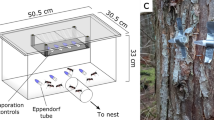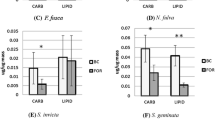Abstract
Animals grow and optimize performance when they collect foods in amounts and ratios that best meet their species-specific nutritional requirements. For eusocial organisms like ants, where only a small fraction of the colony members collect food, increasing evidence demonstrates that strong macronutrient regulation occurs at the colony level. Here, we explored regulation of protein and carbohydrate (p:c) intake in the Rasberry crazy ant, Nylanderia sp. nr. puben. We did this using dry artificial foods (14–42% total macronutrient content) having a range of fixed p:c ratios in a series of choice and no-choice laboratory experiments and used worker mortality to gauge colony-level costs associated with active nutrient regulation. Choice experiments revealed that colonies preferred carbohydrate-rich foods and self-selected a diet having a p:c ratio ~1:2. No-choice experiments demonstrated that food p:c ratio only moderately affected worker food collection behavior, likely because colonies regulated the intake of only the non-limiting nutrients. Absolute worker mortality was generally high, but lowest in colonies feeding on the food having a p:c ratio of 1:2 (the p:c ratio ants self-selected in the choice experiment), although mortality was not significantly affected by food p:c ratio. The self-selected p:c ratio in our study is consistent with that observed in other recent ant nutrient regulation studies. Taken together, the results from these combined studies reveal emerging commonalities among ants in macronutrient regulation strategies, and similarities in foraging behaviors and costs associated with macronutrient regulation. Finally, from a methodological perspective, the high mortality observed in our study, when compared with other recent studies, suggests that ant nutrient regulation studies should be conducted using foods having high moisture and total macronutrient content.



Similar content being viewed by others
References
Banks W.A., Lofgren C.S., Jouvenaz D.P., Stringer C.E., Bishop P.M., Williams D.F., Wojcik D.P. and Glancey B.M. 1981. Techniques for collecting, rearing, and handling imported fire ants. Sci. Educ. Admin. Publ. At. (Ns-21): 1-9
Behmer S.T. 2009. Insect herbivore nutrient regulation. Annu. Rev. Entomol. 54: 165-187
Behmer S.T. and Joern A. 2008. Coexisting generalist herbivores occupy unique nutritional feeding niches. Proc. Natl Acad. Sci. USA 105: 1977-1982
Behmer S.T., Raubenheimer D. and Simpson S.J. 2001. Frequency-dependent food selection in locusts: a geometric analysis of the role of nutrient balancing. Anim. Behav. 61: 995-1005
Cassill D.L. 2003. Rules of supply and demand regulate recruitment to food in the fire ant, Solenopsis invicta. Behav. Ecol. Sociobiol. 54: 441-450
Cassill D.L. and Tschinkel W.R. 1999. Regulation of diet in the fire ant, Solenopsis invicta. J. Insect Behav. 12: 307-327
Chown S.L. and Gaston K.J. 1999. Exploring links between physiology and ecology at macro-scales: the role of respiratory metabolism in insects. Biol. Rev. 74: 87-120
Cook S.C. and Behmer S.T. 2010. Macronutrient regulation in the tropical terrestrial ant Ectatomma ruidum (Formicidae): A field study in Costa Rica. Biotropica 42: 135-139
Cook S.C., Eubanks M.D., Gold R.E. and Behmer S.T. 2010. Colony-level macronutrient regulation in ants: mechanisms, hoarding and associated costs. Anim. Behav. 79: 429-437
Davidson D.W. 1997. The role of resource imbalances in the evolutionary ecology of tropical arboreal ants. Biol. J. Linn. Soc. 61: 153-181
Davidson D.W. 2005. Ecological stoichiometry of ants in a New World rain forest. Oecologia 142: 221-231
Davidson D.W., Cook S.C., Snelling R.R. and Chua T.H. 2003. Explaining the abundance of ants in lowland tropical rainforest canopies. Science 300: 969-972
Dussutour A. and Simpson S.J. 2008. Carbohydrate regulation in relation to colony growth in ants. J. Exp. Biol. 211: 2224-2232
Dussutour A. and Simpson S.J. 2009. Communal nutrition in ants. Curr. Biol. 19: 740-744
Hölldobler B. and Wilson E.O. 1990. The Ants. Springer Verlag, Berlin
LaPolla J.S., Brady S.G. and Shattuck S.O. 2010. Phylogeny and taxonomy of the Prenolepis genus-group of ants (Hymenoptera: Formicidae). Syst. Entomol. 35: 118-131
MacGown J. and Layton B. 2010. The invasive Rasberry crazy ant, Nylanderia sp. near pubens (Hymenoptera: Formicidae), reported from Mississippi. Mid. Entomol. 3: 44-47
Meyers J.M. and Gold R.E. 2008. Identification of an exotic pest ant, Paratrechina sp. nr. pubens (Hymenoptera: Formicidae), in Texas. Sociobiology 52: 589-604
Moreau C.S., Bell C.D., Vila R., Archibald S.B. and Pierce N.E. 2006. Phylogeny of the ants: diversification in the age of angiosperms. Science 312: 101-104
Oster G. and Wilson E.O. 1978. Caste and Ecology in the Social Insects. Princeton University Press, Princeton NJ
Raubenheimer D.J. and Simpson S.J. 1993. The geometry of feeding in the locust. Anim. Behav. 45: 953-964
Simpson S.J. and Raubenheimer D. 1993. A multilevel analysis of feeding-behavior - the geometry of nutritional decisions. Phil. Trans. R. Soc. London Ser. B-Biol. Sci. 342: 381-402
Acknowledgments
The research presented here was conducted by R.A.W. as partial fulfillment of requirements for a M.S. degree. Research was funded by a grant from the Ma-Ran Foundation, and a Crop Protection Graduate Assistantship from DuPont, and in part by a grant from the Texas State FAIAP Program (to S.T.B and R.E.G.).
Author information
Authors and Affiliations
Corresponding author
Rights and permissions
About this article
Cite this article
Cook, S.C., Wynalda, R.A., Gold, R.E. et al. Macronutrient regulation in the Rasberry crazy ant (Nylanderia sp. nr. pubens). Insect. Soc. 59, 93–100 (2012). https://doi.org/10.1007/s00040-011-0193-7
Received:
Revised:
Accepted:
Published:
Issue Date:
DOI: https://doi.org/10.1007/s00040-011-0193-7




